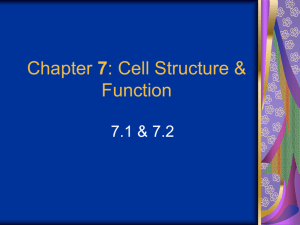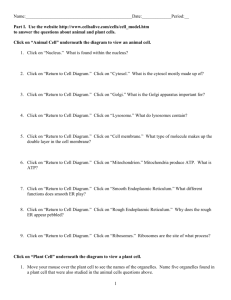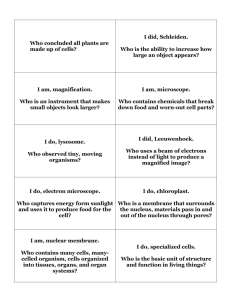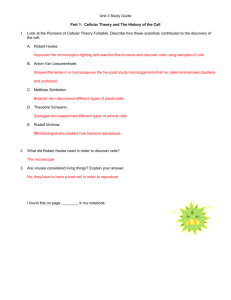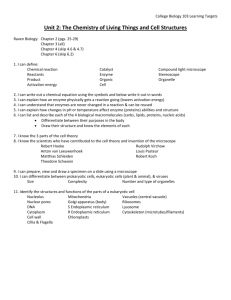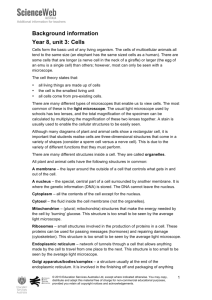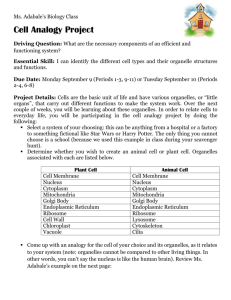Ecology Unit Outline
advertisement
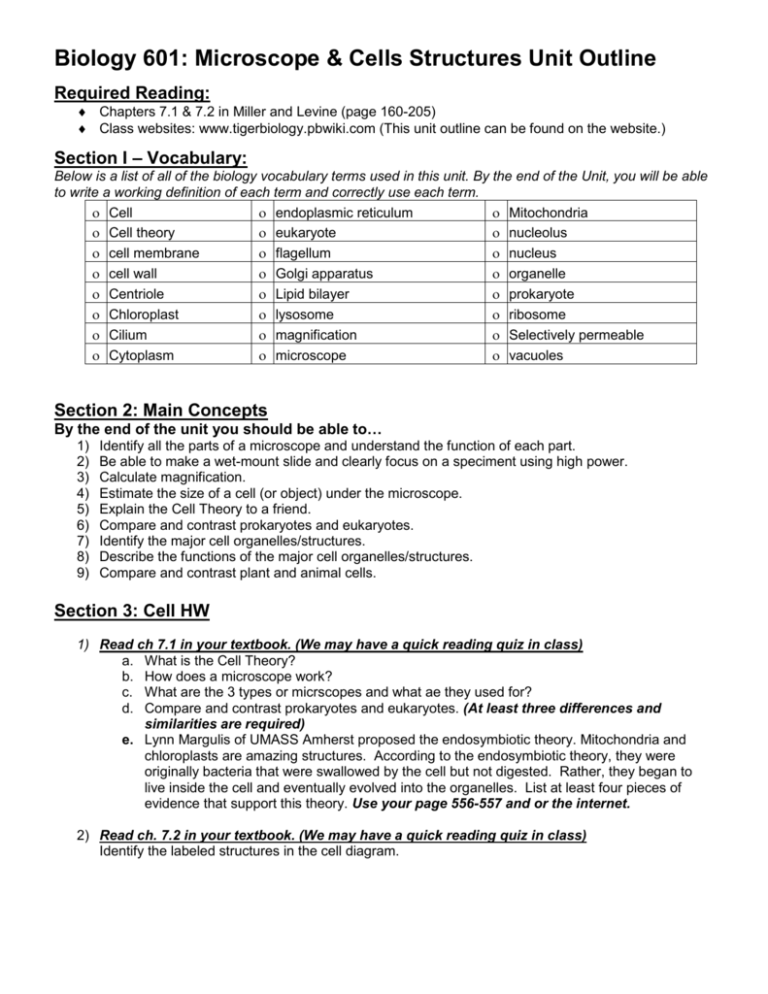
Biology 601: Microscope & Cells Structures Unit Outline Required Reading: Chapters 7.1 & 7.2 in Miller and Levine (page 160-205) Class websites: www.tigerbiology.pbwiki.com (This unit outline can be found on the website.) Section I – Vocabulary: Below is a list of all of the biology vocabulary terms used in this unit. By the end of the Unit, you will be able to write a working definition of each term and correctly use each term. Cell endoplasmic reticulum Mitochondria Cell theory eukaryote nucleolus cell membrane flagellum nucleus cell wall Golgi apparatus organelle Centriole Lipid bilayer prokaryote Chloroplast lysosome ribosome Cilium magnification Selectively permeable Cytoplasm microscope vacuoles Section 2: Main Concepts By the end of the unit you should be able to… 1) 2) 3) 4) 5) 6) 7) 8) 9) Identify all the parts of a microscope and understand the function of each part. Be able to make a wet-mount slide and clearly focus on a speciment using high power. Calculate magnification. Estimate the size of a cell (or object) under the microscope. Explain the Cell Theory to a friend. Compare and contrast prokaryotes and eukaryotes. Identify the major cell organelles/structures. Describe the functions of the major cell organelles/structures. Compare and contrast plant and animal cells. Section 3: Cell HW 1) Read ch 7.1 in your textbook. (We may have a quick reading quiz in class) a. What is the Cell Theory? b. How does a microscope work? c. What are the 3 types or micrscopes and what ae they used for? d. Compare and contrast prokaryotes and eukaryotes. (At least three differences and similarities are required) e. Lynn Margulis of UMASS Amherst proposed the endosymbiotic theory. Mitochondria and chloroplasts are amazing structures. According to the endosymbiotic theory, they were originally bacteria that were swallowed by the cell but not digested. Rather, they began to live inside the cell and eventually evolved into the organelles. List at least four pieces of evidence that support this theory. Use your page 556-557 and or the internet. 2) Read ch. 7.2 in your textbook. (We may have a quick reading quiz in class) Identify the labeled structures in the cell diagram. 3) Read pages 174-181 in your textbook. (We may have a quick reading quiz in class) People often make analogies between cells and other complex organizations like cities, schools, businesses, sports teams, etc. a. Decide on a good analogy for you. b. Then diagram and describe it using the following table. Include at least 8 cellular structures and descriptions of their roles in the cell versus the analogy you’ve picked. Cell Structure Analogous Structure Why is it a good analogy? 1. 2. 3. 4. 5. 6. 7. 8. 4) Compare and contrast plant and animal cells. (At least three differences and similarities are required) 5) Cell Practice Quiz 1. Cells are the basic units of ____________________ and ____________________ in living things. 2. What two organelles do plant cells have that animal cells do not? Match the cell structure above with the definition found below: 3. _____ cell membrane 4. _____ cytoplasm 5. _____ nucleus 6. _____ endoplasmic reticulum 7. _____ Golgi apparatus A. B. C. D. E. F. G. H. I. J. 8. _____ ribosome 9. _____ mitochondria 10. _____ chloroplast 11. _____ vacuole 12. _____ cell wall portion of the cell between the cell membrane and the nucleus modifies, sorts, and packages materials from the endoplasmic reticulum protects the cells and regulates what materials enter and leave the cells contains the green pigment chlorophyll contains nearly all of the cell's DNA saclike structure often used to store materials such as water, salts, and proteins made mostly of cellulose produces proteins by following coded instructions from the nucleus converts chemical energy stored in food into compounds that are more convenient for cells to use made up of two types, rough and smooth; each with its own function
